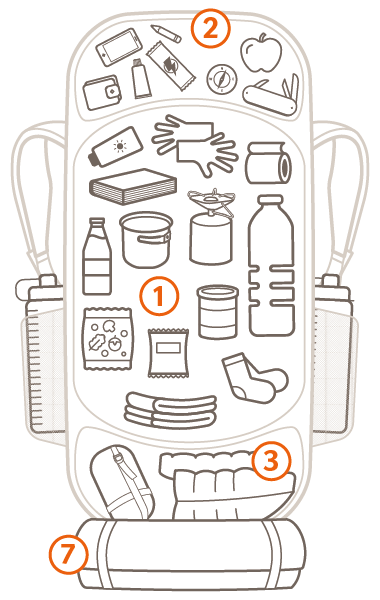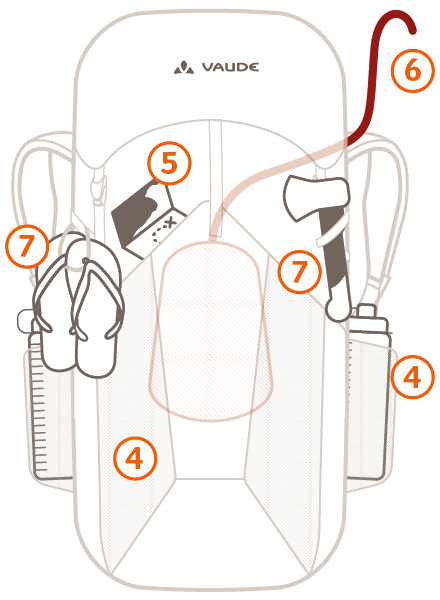How do I pack my backpack correctly?
Packing correctly starts even before you start packing: If you are traveling long distances with a backpack, you should think carefully in advance about what you need and how you will distribute your luggage. As a general rule, keep the weight low and carry a maximum of 25 to 30 percent of your own body weight on longer trips. Children can also go with a children's backpack.
Distributing the weight in your backpack correctly
If the weight in the backpack is well distributed, the center of gravity is close to the body's center of gravity. The backpack then sits comfortably on your back, allowing you to keep your balance and react quickly. To achieve this, the main load should be in the middle and close to the back.
How to organize your backpack correctly




1. Packing the main compartment
Heavy items such as carabiners, wedges, exes, tents, canned food or water supplies should be stowed in the middle and close to your back. This also applies to bottles.
We recommend collapsible bottles. If you don't need them, you can stow them away to save space. Lighter items, such as clothing, should be packed at the bottom, top and sides.
2. What goes in the lid compartment of the backpack?
If your rucksack has a lid compartment, it's best to pack smaller items that you need to have to hand quickly. For example, your cell phone, GPS, compass, handkerchiefs, hat, chocolate bar and first aid kit.
Your valuables are also in good hands here. With some VAUDE backpacks, you can detach the lid compartment from the backpack and use it separately as a small bag. This allows you to take your valuables with you even if you go shopping and leave your backpack in the tent.
3. What the bottom compartment is all about
Backpacks with a volume of 40 liters or more usually have a separate bottom compartment. It is best to stow light and bulky items such as a sleeping bag and insulating jacket here.
However, you may want to pack the items in the bottom compartment in a stuff sack as a precaution: if you wade through a river, the bottom compartment will be the first to get wet.
4. Loading the outer and mesh pockets
Just like the lid compartment, the outer and mesh pockets offer additional storage space for small items that you need quickly and often, such as a rain jacket, hat, handkerchiefs or sun cream. However, make sure that the side pockets of the rucksack have roughly the same weight. Otherwise it will become lopsided.
5. The map compartment
Some VAUDE backpacks have an extra compartment for maps.
6. Where does the hydration bladder go in the backpack?
Almost all VAUDE backpacks have a compartment for hydration bladders. It is always on the back so that the body's center of gravity remains stable. The outlet for the tube is always near the shoulder straps.
7. Attaching equipment to the outside of the backpack
If you want to attach something to the outside of the rucksack, put heavy items such as the tent or rope on top, for example under the lid compartment or on the fastening loops on the lid. Lighter and more robust equipment, such as tent poles, a sleeping mat or sandals, can also be attached to the sides or the front of the rucksack. This keeps the center of gravity in the middle and the items on the outside don't have to worry about getting lost in the undergrowth.
Pack sacks to keep your rucksack tidy
Use pack sacks to keep your backpack organized. The pack sacks also keep your luggage dry and you can stow your food in them so that you can hang it from a tree or store it away from your tent - this will keep you away from curious mice during the night.
Example: How to pack a trekking rucksack correctly
What does the load range of VAUDE backpacks mean?
Under "Data & Details" you will find the item "Load range" for VAUDE backpacks. You can always load less, but you should consider whether a smaller backpack would do.
But you shouldn't load more: the backpack and its stabilizing parts such as the frame are designed for the maximum load. If you pack more, the carrying comfort will suffer.


